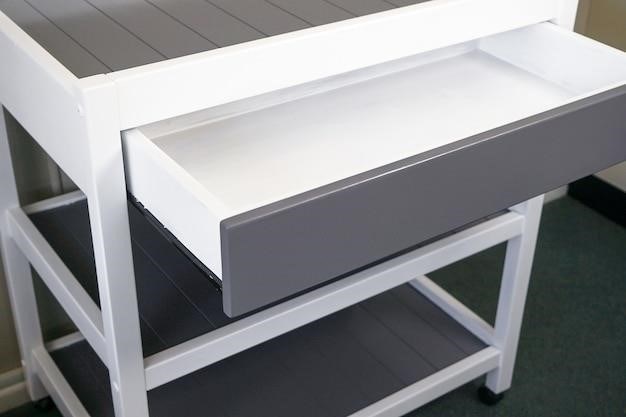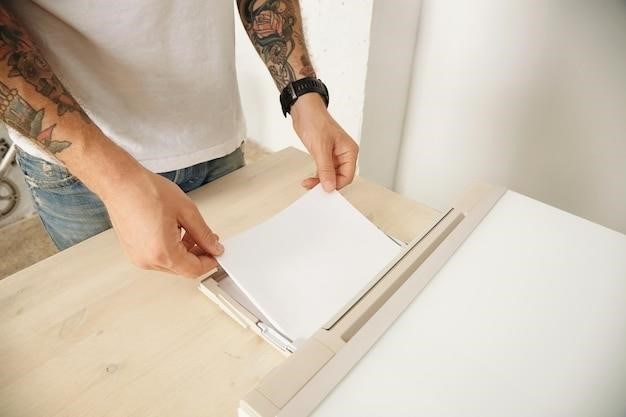Drawer Guide Kit⁚ A Comprehensive Guide
This guide provides a complete overview of drawer guide kits, encompassing various types, installation methods, and maintenance tips․ Learn to choose the right kit for your project, from measuring and tool selection to troubleshooting common installation problems and ensuring smooth, long-lasting drawer operation․ We cover full extension and undermount options, materials, and brand recommendations․
Understanding Drawer Guide Kits
Drawer guide kits are essential components for smooth and reliable drawer operation․ They consist of a pair of slides, one attached to the drawer and the other to the cabinet, allowing the drawer to glide in and out․ Understanding the different types available is crucial for selecting the right kit for your project․ These kits simplify the installation process by providing all the necessary hardware, including screws and potentially even installation jigs for precise alignment․ The quality of the kit significantly impacts the longevity and performance of your drawers․ Factors such as material, weight capacity, and extension type (full extension or partial extension) influence the overall functionality and lifespan of your drawer system․ Properly chosen kits ensure easy drawer access, prevent jamming, and enhance the overall aesthetic appeal of your cabinetry․ Investing in a high-quality kit guarantees a superior user experience and contributes to the durability of your kitchen or furniture project․ Consider the weight of the drawer contents when selecting a kit to ensure sufficient load-bearing capacity․ The installation process itself, while generally straightforward, benefits from careful planning and attention to detail, as outlined in detailed installation guides often included with the kits․ Choosing the appropriate kit for your needs and following the provided instructions guarantees a successful and long-lasting drawer system․
Types of Drawer Slides
Drawer slides come in various configurations, each designed for specific applications and cabinet styles․ The most common types include side-mount slides, which attach to the sides of both the drawer and the cabinet; undermount slides, where the slides are installed beneath the drawer and cabinet; and center-mount slides, where the slides are mounted in the center of the drawer and cabinet․ Side-mount slides are a popular choice due to their ease of installation and wide availability․ Undermount slides offer a sleek, concealed look, ideal for modern cabinetry․ Center-mount slides provide excellent weight capacity and smooth operation, particularly suited for heavy drawers․ Within each category, you’ll find variations in extension capabilities․ Full-extension slides allow the drawer to fully extend, providing complete access to contents, while partial-extension slides only extend partially․ The choice between full and partial extension often depends on available space and the contents of the drawer․ Material also plays a role, with options including steel, metal alloys, and even wood for specific aesthetic preferences․ Consider factors like weight capacity, desired extension, and aesthetic integration with your cabinet style when making your selection․ The type of slide you choose significantly impacts the functionality and overall appearance of your drawers․
Full Extension vs․ Undermount Drawer Slides
The choice between full-extension and undermount drawer slides hinges on both functionality and aesthetics․ Full-extension slides, as their name suggests, allow the drawer to extend completely out of the cabinet, providing unimpeded access to all contents․ This is particularly beneficial for deep drawers or those storing bulky items․ The advantage lies in the ease of retrieval and organization․ However, full-extension slides often require more space within the cabinet and may not be suitable for all cabinet configurations․ Undermount slides, conversely, are installed beneath the drawer and cabinet, resulting in a clean, concealed look that enhances the modern aesthetic․ They are typically less visible than side-mount slides, giving a streamlined appearance to the cabinetry․ Although usually offering slightly less weight capacity than some full-extension options, undermount slides still provide ample support for standard drawer loads․ The decision between these two types depends on your priorities⁚ unrestricted access versus a minimalist, visually appealing design․ Careful consideration of your specific needs and cabinet design is crucial for optimal drawer functionality and appearance․ The installation process also varies slightly depending on the type chosen․

Choosing the Right Drawer Slide Material
Selecting the appropriate material for your drawer slides is crucial for durability, longevity, and smooth operation․ Steel is a popular choice, offering exceptional strength and resilience, making it suitable for heavier drawers and frequent use․ Steel slides are often coated to resist corrosion and maintain a smooth gliding surface, ensuring consistent performance over time․ However, steel can be susceptible to rust in humid environments if not properly protected․ For a more premium feel and enhanced resistance to corrosion, consider slides made from high-quality aluminum․ Aluminum slides offer a lightweight yet robust solution that’s less prone to rust and provides a quieter operation․ They are often preferred in applications where aesthetics are paramount, offering a sleek and modern appearance․ While generally more expensive than steel, their longevity and resistance to wear justify the higher cost․ Finally, wood slides offer a rustic charm, particularly suited to traditional or antique-style cabinetry․ However, their durability and weight capacity are generally lower than steel or aluminum, limiting their suitability to lighter drawers and less frequent use․ The choice depends on your budget, aesthetic preferences, and the intended load and usage of the drawers․ Consider the environment and the weight of the drawer contents before making your final decision․
Measuring for Your Drawer Guide Kit
Accurate measurements are paramount for a successful drawer installation․ Begin by measuring the interior width of your cabinet opening, ensuring you account for any existing framing or obstructions․ This dimension dictates the maximum usable width for your drawer․ Next, measure the interior height of the cabinet, determining the available vertical space for the drawer and its slides․ Remember to factor in the thickness of the drawer itself and any desired clearance between the drawer bottom and the cabinet floor․ This clearance is crucial for smooth operation and prevents the drawer from dragging or binding․ Then, carefully measure the depth of the cabinet, considering both the front-to-back dimension and the available space for the drawer slides within the cabinet’s side walls․ Remember that the slides’ mounting brackets will need adequate space for secure attachment․ Finally, measure the dimensions of the drawer itself⁚ its width, depth, and height․ Accurate measurements of both the cabinet and the drawer are essential for selecting the correct size of drawer slides and ensuring a perfect fit․ Keep a detailed record of your measurements to avoid errors during the installation process․ These careful measurements will ensure seamless drawer functionality and a professional-looking finish․
Tools and Materials Needed for Installation
Before commencing the installation, gather the necessary tools and materials․ This ensures a smooth and efficient process․ You’ll need your chosen drawer guide kit, which should include the slides themselves, mounting hardware (screws), and possibly additional components depending on the type of slides․ A measuring tape is essential for double-checking dimensions and ensuring accurate placement of the slides․ A pencil will be used for marking screw locations on the cabinet and drawer․ A screwdriver, ideally both Phillips and flathead, will be needed to fasten the mounting hardware․ A drill with appropriate drill bits is crucial for pre-drilling pilot holes, preventing wood splitting, and ensuring a secure attachment․ A level is essential to ensure that the drawer slides are installed perfectly parallel to the ground, preventing any issues with drawer alignment or operation․ Consider using a countersinking bit to recess the screw heads for a clean, flush finish․ Depending on the type of slides, you might need additional tools like a jig for precise alignment of the slides or a mallet for gentle adjustments․ Having all these tools readily available will streamline the installation process, helping you avoid frustrating delays and ensuring a professional outcome․
Step-by-Step Installation Guide
Begin by carefully reviewing the manufacturer’s instructions specific to your chosen drawer guide kit․ These instructions often contain diagrams and detailed explanations․ Accurate measurement is key; carefully measure the drawer opening and the drawer itself to ensure a precise fit․ Next, using a pencil, mark the locations where the slides will be mounted on both the cabinet and the drawer․ Pre-drilling pilot holes is crucial to prevent wood splitting and ensure a secure attachment․ Use the appropriate drill bit size for your screws․ Attach the slide components to the cabinet sides, ensuring they are level and securely fastened using the provided screws․ Carefully align the corresponding slide components to the drawer, again pre-drilling holes and securing them firmly․ Once both sides are attached, carefully slide the drawer into the cabinet, checking for smooth operation and proper alignment․ Make any necessary adjustments before completely tightening all screws․ Testing the drawer’s extension and retraction is vital to confirm proper functionality․ If any issues arise, refer back to the manufacturer’s instructions or the troubleshooting section of this guide․ Remember, patience and attention to detail are essential for a successful installation․
Installing Drawer Slides into the Cabinet
Precise measurements are paramount for successful installation․ Before commencing, double-check your measurements against the drawer opening and the drawer itself, ensuring a perfect fit․ Using a pencil, carefully mark the exact locations for the slide mounting points on the cabinet’s interior side panels․ Pre-drilling pilot holes is highly recommended to prevent wood splitting during screw insertion, ensuring a secure and stable attachment․ Select a drill bit slightly smaller than the diameter of the screws provided with the kit․ Next, firmly position the cabinet-side slide components against the marked locations, ensuring they are perfectly level and aligned․ Use the provided screws to fasten the slides to the cabinet․ Begin by lightly tightening the screws to allow for minor adjustments if necessary․ Once you’re satisfied with the alignment, firmly tighten all screws․ Take your time and carefully ensure that both sides are mounted identically, maintaining perfect symmetry․ This will contribute to the smooth operation of the drawer․ Before proceeding to install the drawer slides, inspect your work to ensure everything is secure and aligned correctly․ Careful preparation at this stage will minimize potential problems during the subsequent steps․
Installing Drawer Slides into the Drawer
With the cabinet-mounted slides securely in place, attention shifts to the drawer itself․ Carefully examine the drawer slide components designed for attachment to the drawer․ These usually consist of a pair of brackets or runners, mirroring the cabinet-side components․ Before proceeding, ensure that the drawer is free of any obstructions or impediments that might interfere with the installation process․ This includes checking for any remnants from previous installations or any debris that could hinder the smooth operation of the slides․ Using a pencil, lightly mark the intended locations for the drawer-side slide components․ These markings should align precisely with the dimensions of the drawer slides․ Pre-drilling pilot holes on the drawer bottom is crucial, particularly for softer wood types, to prevent splitting․ Use a drill bit that’s slightly smaller in diameter than your screws․ Next, carefully attach the drawer-side slide components to the drawer bottom, ensuring perfect alignment with the markings․ Begin by loosely tightening the screws to allow for minor adjustments․ Once you’re satisfied with the alignment, firmly tighten all screws․ A consistent and even tightening pressure is essential for optimal performance․ With the drawer slides securely fixed to the drawer, carefully insert the drawer into the cabinet․ Test the functionality to ensure smooth operation and alignment․ Address any alignment issues immediately, making adjustments as needed․
Troubleshooting Common Installation Problems
During drawer slide installation, several issues might arise․ A common problem is misalignment, where the drawer doesn’t slide smoothly or binds․ This often stems from inaccurate measurements or uneven screw tightening․ Carefully re-check the alignment of both the cabinet and drawer-mounted slides, ensuring they are parallel and properly spaced․ Loose screws can cause instability and wobbling․ Tighten all screws to ensure a secure connection; however, avoid over-tightening, which can strip the wood or damage the slides․ If the drawer binds in a specific area, investigate for any obstructions․ Remove the drawer and carefully inspect for interfering wood shavings or debris․ Sometimes, the drawer might be slightly too wide or tall for the cabinet opening․ In such cases, carefully planing or sanding down the drawer might be necessary to achieve a perfect fit․ If the drawer still doesn’t function correctly after these adjustments, ensure that the drawer slides themselves are not damaged or defective․ Replace any damaged components․ Remember that different drawer slides might have slightly different installation procedures․ Consult the manufacturer’s instructions to address any specific concerns․ If the problem persists despite your efforts, seeking assistance from a professional might be beneficial to avoid further damage․
Adjusting Drawer Slide Alignment
Achieving perfect drawer alignment is crucial for smooth and effortless operation․ Slight misalignments can lead to binding, sticking, or even damage to the drawer slides over time․ Begin by checking for levelness․ Use a level to ensure that both the cabinet and the drawer are perfectly level․ Any discrepancies can be corrected by adjusting the mounting screws, carefully loosening and retightening as needed․ If the drawer is binding at the front, the front-most mounting screws of the drawer slides might require adjustment․ Slightly loosening and then carefully re-tightening these screws can shift the drawer forward or backward․ Conversely, if the drawer binds at the back, adjust the rear-most mounting screws․ Remember to make small, incremental adjustments, testing the drawer’s movement after each minor change․ For side-to-side misalignment, inspect the alignment of the drawer slides on both the cabinet and the drawer․ The slides should be precisely parallel․ Minor adjustments to the mounting screws on either side can correct this․ If the drawer is tilting, adjust the screws on the lower side to raise that corner, or the screws on the higher side to lower it․ Always maintain a balance to avoid over-tightening any individual screw․ If the alignment problems persist despite careful adjustments, consider checking for any obstructions that might be interfering with the smooth movement of the drawer․ Remember that patience and precision are vital for achieving optimal alignment․
Maintaining Your Drawer Slides

Regular maintenance ensures your drawer slides continue functioning smoothly and prevents premature wear․ Periodically inspect the slides for any signs of damage, such as cracks, bends, or excessive wear․ Pay close attention to the rollers or wheels, checking for debris buildup․ Use a soft cloth or brush to remove any dust, dirt, or grime․ For stubborn grime, a mild detergent solution can be used, but avoid harsh chemicals that might damage the slide material․ Always ensure the slides are completely dry before reinstalling the drawer․ Lubrication can significantly extend the life and smooth operation of your drawer slides․ Apply a small amount of silicone-based lubricant or specialized drawer slide lubricant to the moving parts․ Avoid using oil-based lubricants, as they can attract dust and grime, ultimately hindering movement․ Apply the lubricant sparingly; too much can attract dirt․ After lubrication, gently open and close the drawer several times to distribute the lubricant evenly․ Avoid overloading your drawers․ Overloading can put excessive strain on the slides, leading to premature wear and tear․ Distribute the weight evenly within the drawer to minimize stress on any single point․ Addressing minor issues promptly can prevent them from escalating into more significant problems․ Regular inspection and simple maintenance will keep your drawers gliding smoothly for years to come, preserving the integrity of your kitchen cabinets and overall functionality․
Recommended Drawer Guide Kit Brands
Selecting a reputable brand ensures quality, durability, and smooth operation of your drawer slides․ Several well-established brands offer a wide range of drawer guide kits to suit various needs and budgets․ Researching different brands allows you to compare features, warranties, and customer reviews to make an informed decision․ Consider factors like the weight capacity of the slides, the type of extension (full or partial), and the material used in construction when choosing a brand․ Some brands are known for their innovative designs and advanced features, while others focus on affordability and reliable performance․ Reading online reviews and seeking recommendations from experienced professionals can help you narrow down your options and identify brands with a strong track record of customer satisfaction․ Pay attention to the warranty offered by each brand, as this indicates their confidence in the quality and longevity of their products․ A longer warranty often translates to higher-quality materials and manufacturing processes․ Factors such as ease of installation and the availability of replacement parts should also be considered․ Ultimately, the best brand for you will depend on your specific needs and preferences, but researching different brands will ensure you make a well-informed choice that provides years of reliable service․
